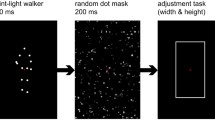Abstract
The Perky Effect (from Perky, 1910) broadly concerns the interaction of imagined and perceived stimuli. Typically this interaction has been interference, although some recent research has suggested language evoked spatial representations could actually facilitate perceptual task performance at corresponding spatial locations. The current study explored whether comprehending language interfered with or facilitated the perceptual task at the implied spatial locations as a matter of language length. In Study 1, participants read power words followed by a figure recognition task that appeared at either the upper or lower part of the screen. It was found comprehending power words interfered with perception of the visual stimulus at the implied spatial locations. Study 2 used the same paradigm but with power sentences. We failed to observe the interaction between the power sentences and the visual figure spatial location. The combined results of Study 1 and Study 2 suggest that the spatial mental representations of language are consistent with past perceptual research on the Perky Effect, but only as a short-lived phenomenon.

Similar content being viewed by others
References
Barsalou, L. W. (1999). Perceptual symbol systems. Behavioral and Brain Sciences, 22, 577–609.
Bergen, B., Lindsay, S., Matlock, T., & Narayanan, S. (2007). Spatial and linguistic aspects of visual imagery in sentence comprehension. Cognitive Science, 31, 733–764.
Connell, L. (2007). Representing object colour in language comprehension. Cognition, 102, 476–485.
Craver-Lemley, C., & Arterberry, M. E. (2001). Imagery-induced interference on a visual detection task. Spatial Vision, 14, 101–119.
Craver-Lemley, C., & Reeves, A. (1987). Visual imagery selectively reduces Vernier acuity. Perception, 16, 599–614.
Craver-Lemley, C., & Reeves, A. (1992). How visual imagery interferes with vision. Psychological Review, 99, 633–649.
Estes, Z., Verges, M., & Barsalou, L. W. (2008). Head up, foot down: Object words orient attention to the objects’ typical location. Psychological Science, 19, 93–97.
Fischer, Z. (2018). Embodied language: A review of the role of the motor system in language comprehension. Quarterly Journal of Experimental Psychology (2006), 61(6), 825–850. https://doi.org/10.1080/17470210701623605.
Glenberg, A. M. (1997). What memory is for. Behavioral & Brain Sciences, 20, 1–55.
Glenberg, A. M., & Robertson, D. A. (1999). Indexical understanding of instructions. Discourse Processes, 28, 1–26.
Ishai, A., & Sagi, D. (1997). Visual imagery facilitates visual perception: Psychophysical evidence. Journal of Cognitive Neuroscience, 9, 476–489.
Jiang, M., & Henley, T. (2012). Power: Spatial relations as perceptual symbols. Journal of Cognitive Psychology (Formerly: European Journal of Cognitive Psychology), 24, 829–834.
Lakoff, G., & Johnson, M. (1980). Metaphors we live by. University of Chicago Press.
Lawson, R., & Humphreys, G. W. (1996). View specificity in object processing: Evidence from picture matching. Journal of Experimental Psychology: Human Perception and Performance, 22, 395–416.
MacKinnon, N. J., & Langford, T. (1994). The meaning of occupational prestige scores: A social psychological analysis and interpretation. The Sociological Quarterly, 35, 215–245.
Nanay, B., Brown, R., & Brown, R. (2015). Perceptual content and the content of mental imagery. Philosophical Studies, 172(7), 1723–1736.
Perky, C. W. (1910). An experimental study of imagination. American Journal of Psychology, 21, 422–452.
Reeves, A., & Craver-Lemley, C. (2012). Unmasking the Perky effect: Spatial extent of image interference on visual acuity. Frontiers in Psychology, 3, 1–7.
Reeves, A., Grayhem, R., & Craver-Lemley, C. (2020). The Perky effect revisited: Imagery hinders perception at high levels, but aids it at low. Vision Research (Oxford), 167, 8–14. https://doi.org/10.1016/j.visres.2019.12.004.
Richardson, D. C., Spivey, M. J., Barsalou, L. W., & McRae, K. (2003). Spatial representations activated during real-time comprehension of verbs. Cognitive Science, 27, 767–780.
Roldan, S. (2017). Object recognition in mental representations: Directions for exploring diagnostic features through visual mental imagery. Frontiers in Psychology, 8, 1–13. https://doi.org/10.3389/fpsyg.2017.00833.
Schubert, T. W. (2005). Your highness: Vertical positions as perceptual symbols of power. Journal of Personality and Social Psychology, 89, 1–21.
Wiemer-Hastings, K., & Xu, X. (2005). Content differences for abstract and concrete concepts. Cognitive Science, 29, 719–736.
Wilson, M. D. (1988). MRC Psycholinguistic Database: Machine-readable dictionary, Version 2. Behavior Research Methods, Instruments, and Computers, 20(1), 6–11.
Zwaan, R. A., & Kaschak, M. P. (2008). Language in the brain, body, and world. In P. Robbins & M. Aydede (Eds.), The Cambridge handbook of situated cognition (pp. 368–381). Cambridge University Press.
Zwaan, R. A., Stanfield, R. A., & Yaxley, R. H. (2002). Language comprehenders mentally represent the shapes of objects. Psychological Science, 13, 168–171.
Zwaan, R. A., Madden, C. J., Yaxley, R. H., & Aveyard, M. E. (2004). Moving words: Dynamic representations in language comprehension. Cognitive Science, 28, 611–619.
Author information
Authors and Affiliations
Corresponding author
Ethics declarations
Disclosure of Potential Conflicts of Interest
The authors declare that they have no conflict of interest.
Research Involving Human Participants
All procedures performed were in accordance and with the 1964 Helsinki declaration and its later amendments or comparable ethical standards and ethical approval was obtained from Texas A&M University-Commerce Institutional Review Board (Reference number: #2008–001).
Informed Consent
Informed consent was obtained from all individual participants included in the study.
Additional information
Publisher’s Note
Springer Nature remains neutral with regard to jurisdictional claims in published maps and institutional affiliations.
Rights and permissions
About this article
Cite this article
Jiang, M., Henley, T. Perceiving power: A study of spatial relations as perceptual symbols. Curr Psychol 42, 3559–3566 (2023). https://doi.org/10.1007/s12144-021-01713-8
Accepted:
Published:
Issue Date:
DOI: https://doi.org/10.1007/s12144-021-01713-8




